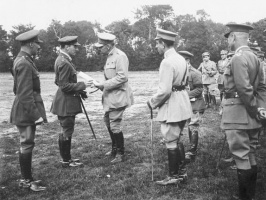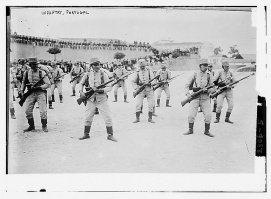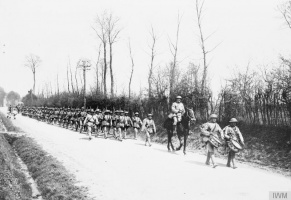Academic Profile and First Military Activities↑
General Fernando Tamagnini de Abreu e Silva (1856-1924) was born on 14 May 1856 in the parish of Santa Maria dos Olivais in Tomar and died on 23 November 1924 in Lisbon. He was son of António Eleutério Dias da Silva and Angélica Tamagnini Dias e Silva.[1]
At the age of seventeen he began his military career as a volunteer in the Cavalry Regiment N.° 2. As a cavalry officer he obtained the following ranks: lieutenant (1883), captain (1888), major (1889), lieutenant colonel (1903), colonel (1909) and general (1915).[2]
Command of the Instruction Division and “The Miracle of Tancos”↑
General Tamagnini was a disciplined military man, which led the war minister, General Norton de Matos (1867-1955), to appoint him commander of the Instruction Division at the Centre of Military Formation in Tancos between April and June 1916. After the instruction in Tancos the troops were ordered to return home, which prompted some desertions. The strong resistance to military embarkation made by opponents of the Democratic Party’s warmongering policy materialized with the Tomar Revolt.[3] In response, the war minister called on General Tamagnini to quell the rebellion. Accompanied by a chosen group of officers, he went through the places of insurrection and contained the rebels without bloodshed. After completing this mission, he asked to be exonerated as commander of the 5th and 7th Divisions in order to focus on the expeditionary forces.
Commander of the Portuguese Expeditionary Corps↑
On 21 February 1917, General Fernando Tamagnini left for Paris, France, and on 1 March 1917, he arrived at the front. On 10 March 1917 he took command, reading a mobilizing proclamation to the troops. As soon as he got ahead, he realized the need to supplement the instruction, recognizing the deficiencies of the training in Tancos. On 25 July 1917, the political decision to elevate the Portuguese Expeditionary Corps to the Army Corps, without sufficient means to guarantee their autonomy, greatly concerned General Tamagnini.[4] Having perceived British resistance to the Portuguese military units, and lacking men, equipment and organization, he intensified his requests to Lisbon. On 5 November 1917, he assumed command of the front with the Portuguese Expeditionary Corps consisting of two divisions. Devoid of men and equipment, he decided to go to Lisbon and in February 1918 he explained the situation and presented his resignation to General Sidónio Pais (1872-1918), president of the Republic, who refused to accept it and promised to send reinforcements.[5] His promises were never carried out and the officers who went to Lisbon did not return. Fearing a tragic situation, Tamagnini called for the surrender of the Portuguese troops to the British Command, which was not attended to, because the war effort was focused on the Somme offensive.[6]
Between 6 and 7 April 1918, two brigades of the 1st Division of Portuguese Expeditionary Corps retired from the front to the rear, leaving the 2nd Division under the command of General Gomes da Costa (1863-1929). Fatigue and discouragement after many months at the front led General Tamagnini to request the withdrawal of the 2nd Division of the Commander of the 1st British Army. Tamagnini found his request accepted and promised to replace the troops. Three days later the withdrawal order was issued, it was scheduled to take place on 9, 10 and 11 April 1918, precisely on the days when General Ferdinand von Quast (1850-1939) unleashed an attack and crushed the 2nd Portuguese Division.
Exoneration of the Commander of the Portuguese Expeditionary Corps and Return to Portugal↑
On 10 June 1918, President Pais relieved General Tamagnini from the command of the Portuguese Expeditionary Corps and replaced him with General Garcia Rosado (1864-1937). The delayed replacement put General Tamagnini and the Portuguese Expeditionary Corps in a very difficult situation. On 29 August 1918, he arrived in Lisbon and moved away from the political-military arena. Due to the outbreak of the military and civilian movement linked to the Democratic Party beginning on 13 October 1918, Sidónio Pais summoned him four days later to the Palace of Belem and handed him the command of the 5th Division. General Tamagnini accepted the assignment, but refused to serve any personal interests or party factions. This attitude was verified in several moments and situations: in disciplinary and educational issues concerning the values of order and obedience in the politicized quarters of the 5th Division, in the political process after Pais’ assassination, and in the initiatives supporting military order and union. General Tamagnini’s involvement in the post-war events – 18 October 1918 and January 1919 – raised suspicion in some Republicans sectors. In turn he requested an investigation into his military performance. On 19 March 1919, the investigation was completed with a compliment to his military performance. Disillusioned with the political military, he stepped away from the corridors of power. However, he would still perform some high military posts far from the command of military units as member of the Council of Promotions (1919-1921) and member of the Supreme Military Court (1921-1923).
Literary Production and Military Decorations↑
Tamagnini wrote Memórias do general, 1915-1919. “Os meus três commandos” (The General’s Memoirs, 1915-1919. “My Three Commands”) and the Campaign Diary of General Fernando Tamagnini, 21 February 1917 to 24 August 1918. He was awarded several insigne, including the Legion d'honneur by the French Republic (1919) and the Military Order of the Tower and Sword, Valour, Loyalty and Merit (1920).
José Luís Assis, Universidade Nova de Lisboa
Section Editor: Ana Paula Pires
Notes
- ↑ Arquivo Histórico Militar, 3.ª Divisão, 7.ª Secção, Processo 909.
- ↑ Ibid.
- ↑ Borges, João Vieira / Marques, Isabel Pestana / Dias, Eurico Gomes: Diário de Campanha do General Fernando Tamagnini, Comandante do CEP, Lisbon 2018, p. 26.
- ↑ Ibid., p. 415.
- ↑ Ibid., p. 416.
- ↑ Carvalho, Vasco de: A 2ª Divisão Portuguesa na Batalha de Lys (9 de abril de 1918), Lisbon 1924, p. 40.
Selected Bibliography
- Arquivo Histórico Militar, Lisbon, 3ª Divisão, 7ª Secção, Caixa 709, General Fernando Tamagnini de Abreu e Silva.
- Arquivo Histórico Militar, Lisbon, FP 51, Série 3, Caixa 858.
- Carvalho, Vasco de: A 2a Divisão portuguesa na Batalha do Lys, 9 de abril de 1918 (The 2nd Portuguese division in the Battle of La Lys, 9 April 1918), Lisbon 1924: Lusitania Editora.
- Marques, Isabel Pestana / Dias, Eurico Gomes / Borges, João Vieira: Diário de campanha do general Fernando Tamagnini, comandante do CEP (The campaign diary of General Fernando Tamagnini, CEP commander), Lisbon 2018: Comissão Portuguesa de História Militar.
- Matos, Norton de: Memórias e trabalhos da minha vida (Memories and works of my life), volume 1, Coimbra 2004: Imprensa da Universidade de Coimbra.
- Tamagnini, Fernando, Marques, Isabel Pestana (ed.): Memórias do general, 1915-1919. 'Os meus três comandos' de Fernando Tamagnini (The general’s memoirs, 1915-1919. 'My Three Commands' by Fernando Tamagnini), Viseu 2004: Sacre.











